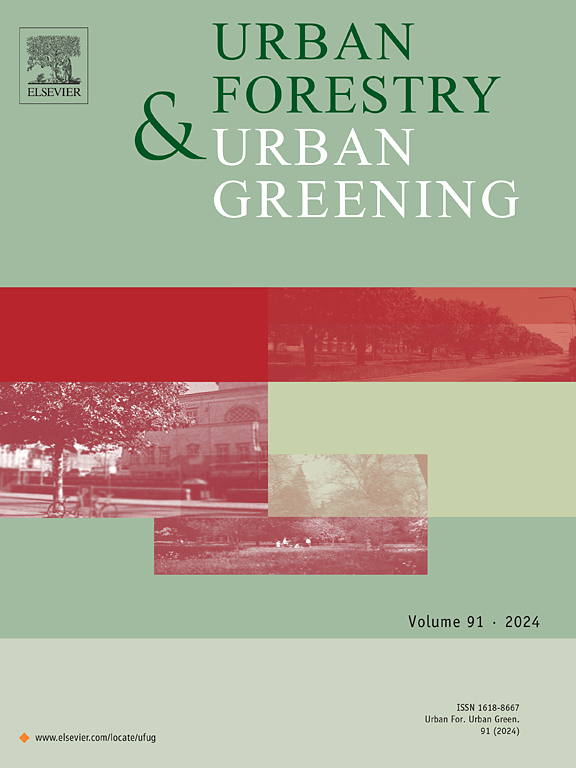Exploring the interplay of urban form and greenery in residents’ affective and cognitive responses
IF 6
2区 环境科学与生态学
Q1 ENVIRONMENTAL STUDIES
引用次数: 0
Abstract
Stress is a prevalent issue in modern cities, exacerbated by urban development and significantly affecting urban dwellers. While it is known that greenery can contribute to people’s wellbeing, it is unclear if it can mitigate the negative effects of urban development. In this study, we aim to explore the intricate dynamics between urban form and greenery to dissect their collective effect on human wellbeing, operationalized through physiological relaxation, preference, and emotional responses. The study employs an experimental study design using virtual reality technology to immerse participants (n=156) into residential neighborhood scenes, and measures affective and cognitive responses using skin conductance measures and a survey, respectively. In general, the findings confirm the critical role of urban greenery on affective and cognitive responses. Interestingly, we observe that this effect is highly dependent on the context and shows diverging patterns between different neighborhood types. In particular, in certain neighborhoods (popular, 60 s, and cooperative), greenery, no matter if species-poor or biodiverse, consistently improves preference and physiological relaxation. In contrast, urban centers and single-family residential areas may accommodate more biodiverse green spaces without compromising their existing high preference levels when compared to less affluent neighborhoods. The study concludes with a call for urban planning to cultivate equitable, green, and distinctively designed urban environments. This shift underscores the critical role of innovative urban design in improving the wellbeing of urban dwellers.
探索城市形态和绿化在居民情感和认知反应中的相互作用
压力是现代城市的一个普遍问题,城市发展加剧了这一问题,并对城市居民产生了重大影响。众所周知,绿化有助于提高人们的幸福感,但绿化能否减轻城市发展的负面影响,目前尚不清楚。在本研究中,我们旨在探索城市形态与绿化之间错综复杂的动态关系,剖析它们对人类福祉的共同影响,并通过生理放松、偏好和情绪反应来实现。本研究采用了实验研究设计,利用虚拟现实技术让参与者(人数=156)沉浸到住宅区场景中,并分别使用皮肤电导测量法和调查法测量情感和认知反应。总体而言,研究结果证实了城市绿化对情感和认知反应的关键作用。有趣的是,我们观察到这种影响高度依赖于环境,并且在不同的社区类型之间表现出不同的模式。特别是在某些社区(大众社区、60 年代社区和合作社区),绿化,无论是物种贫乏还是生物多样性,都能持续改善人们的偏好和生理放松。相反,与不太富裕的社区相比,城市中心和单户住宅区可以容纳更多的生物多样性绿地,而不会影响其现有的高偏好水平。研究最后呼吁,城市规划应培养公平、绿色和设计独特的城市环境。这一转变强调了创新城市设计在改善城市居民福祉方面的关键作用。
本文章由计算机程序翻译,如有差异,请以英文原文为准。
求助全文
约1分钟内获得全文
求助全文
来源期刊

Urban Forestry & Urban Greening
FORESTRY-
CiteScore
11.70
自引率
12.50%
发文量
289
审稿时长
70 days
期刊介绍:
Urban Forestry and Urban Greening is a refereed, international journal aimed at presenting high-quality research with urban and peri-urban woody and non-woody vegetation and its use, planning, design, establishment and management as its main topics. Urban Forestry and Urban Greening concentrates on all tree-dominated (as joint together in the urban forest) as well as other green resources in and around urban areas, such as woodlands, public and private urban parks and gardens, urban nature areas, street tree and square plantations, botanical gardens and cemeteries.
The journal welcomes basic and applied research papers, as well as review papers and short communications. Contributions should focus on one or more of the following aspects:
-Form and functions of urban forests and other vegetation, including aspects of urban ecology.
-Policy-making, planning and design related to urban forests and other vegetation.
-Selection and establishment of tree resources and other vegetation for urban environments.
-Management of urban forests and other vegetation.
Original contributions of a high academic standard are invited from a wide range of disciplines and fields, including forestry, biology, horticulture, arboriculture, landscape ecology, pathology, soil science, hydrology, landscape architecture, landscape planning, urban planning and design, economics, sociology, environmental psychology, public health, and education.
 求助内容:
求助内容: 应助结果提醒方式:
应助结果提醒方式:


